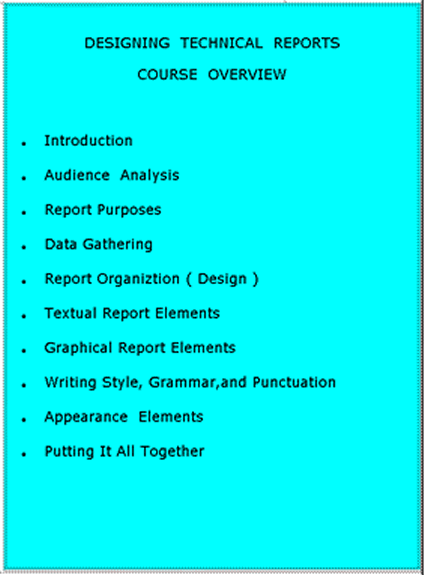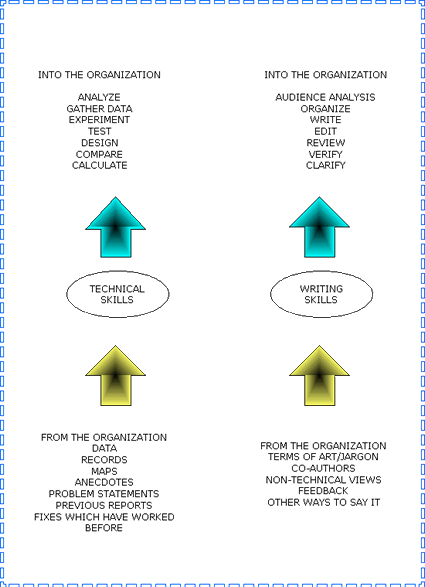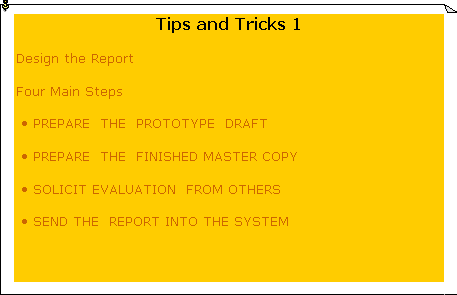
Technical Report Writing
CHAPTER 1 Introduction
A. Course Overview
An overview of this course is presented below as Figure 1-1. Take a moment to glance through the topics to be covered and then consider this one central idea. The premise of this course is that good technical reports don't just happen. They are "designed". Their design may be learned and that knowledge can be applied in your everyday work in the same way as you apply your other technical skills. We cannot all be William Shakespeare or Ernest Hemingway, but it is possible to acquire enough writing skill to write simple, declarative sentences and readable reports. Subjects you know about, you can also learn to write about.

B.
Types of Reports
The suggestions presented in this course
may be employed whether you are writing a single page letter report or a multi-volume
research study. That is true because technical reports do, or at least should,
have an explicit purpose and an identifiable audience. If you know clearly "why"
you are writing and "who" will read your report, you have the basis
for the report design. Your audience, and their needs, must remain at the forefront
of your thinking as you write. In most organizations, the audience is a multi-layered
collection of people. Some of your intended readers may be known to you while
others may not. Once you have determined the purpose of your writing, you need
to analyze your audience to the best of your ability. This course will suggest
some ways to do that in systematic fashion.
C.
Audiences
Three broad categories of audiences
for a technical report can usually be identified from the beginning.
Technical audiences
are made up of people in the same field as yours. They are the most obvious
audience but are seldom your most important audience. They are people such as
other engineers, technicians or scientists. They may be people you know within
your own organization or they may work outside of it. Their interests may include
other things as well, but it is almost certain that they will have an interest
in the subject of the report which is similar to your own.
Non-technical readers of your report may
include for example, citizen advisory boards, financial experts, legal or administrative
readers, and many, many others. Their needs will be quite different from your
"technical" readers. As they read your report they are looking for
certain things which it is your job, as a technical writer, to provide.
The most common audiences include both
technical and non-technical readers. Such Mixed or Multi-layered audiences
are more difficult to write for, but there are several principals of report
design which, if followed, will provide each reader with the information he
or she needs to use your report efficiently.
Above all, there is one thing nearly
all your readers have in common. They are usually busy people who have a great
deal of reading to do every day. If you hand them a thick, turgid, complicated
and badly written report you will alienate them immediately. Their first instinct,
when handed such a report, is to ask, "Is there any way I can avoid reading
this ?". Overcoming this natural reaction is a challenge, but you can make
it easier on both them and yourself if you design your report properly. Principles
of good report design are mainly covered in Chapter 5 later in this course.
Once the subject of your report has been identified and its purpose defined,
your first task is to analyze your audience.
D. Audience Analysis and Why You Need
to Care
One of your early tasks as a report
writer is to identify and analyze your audiences. You want to know things about
them such as; what their technical background is, what their function in the
organization is, what their interests are and what level of detail they need
from your report for it to be useful to them.
These questions are dealt with in some
detail later in Chapter 2, but for now, recognize that unless you ask these
questions you are doomed to almost certain failure in your purpose. Those who
must act upon the basis of your report will not act unless you give them a good
reason to. They may be inclined to favor your recommendations or embrace your
ideas but they will not be convinced unless you convince them. You can only
do that if you give them the information they must have to make their decisions
and do their jobs.
E. Summing Up
Figure 1-2 (below) illustrates your split
personality as technical writer/practitioner. Most of us work within some organizational
system with which we try to communicate through our technical writing activities.
In this course, the aim is to help you do that in the most effective way possible.

Figure 1-2
****

****